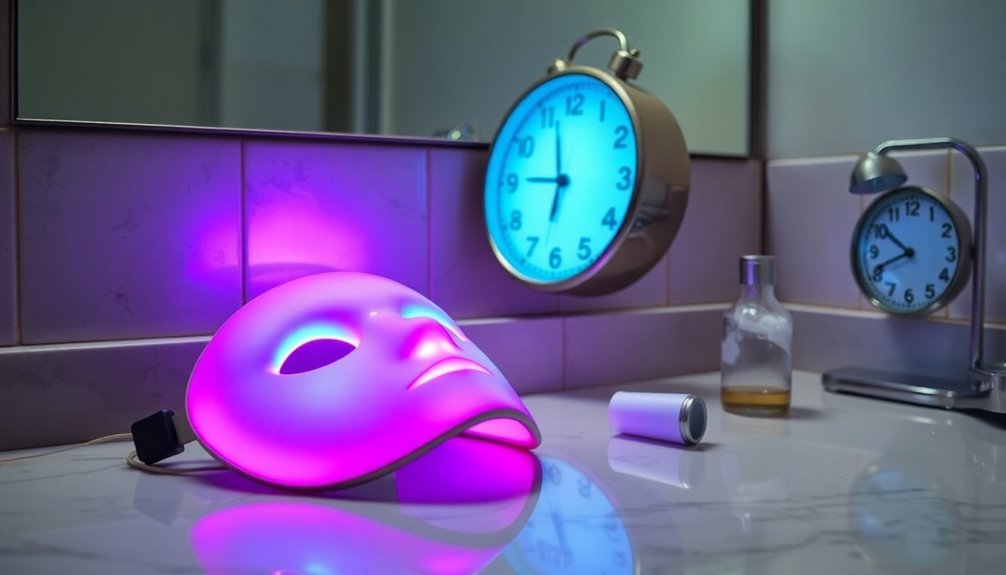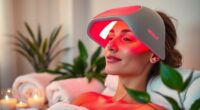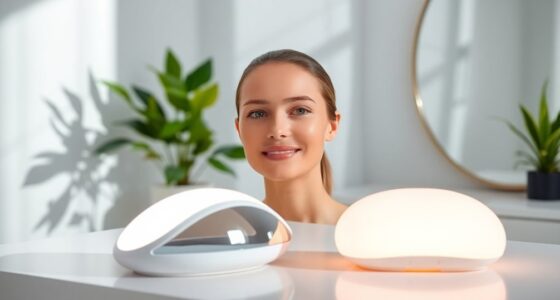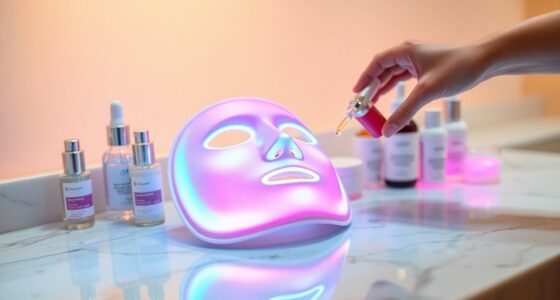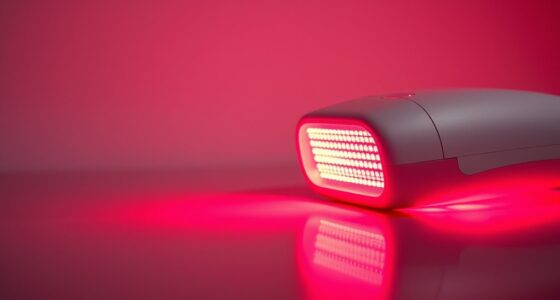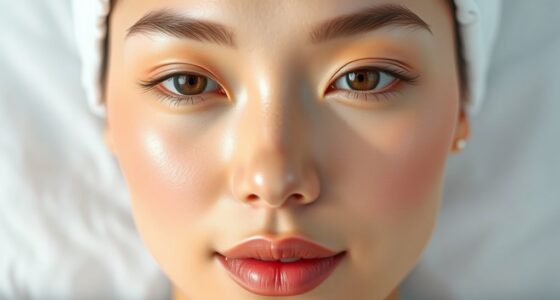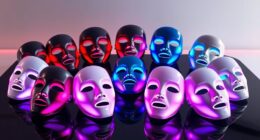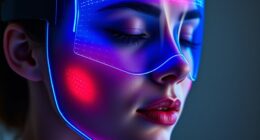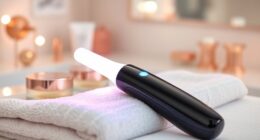If you're overusing your LED light therapy mask, watch for signs that can indicate trouble. First, look out for skin irritation and redness; these are common responses to overuse. You might also notice the mask's effectiveness dwindling, as your skin becomes accustomed to the treatment. Eye damage is another concern, especially with prolonged exposure. If you have increased photosensitivity or a drop in your device's quality, it's time to reassess your usage. Recognizing these signs can help keep your skin healthy and glowing. There's more you can discover about safely enjoying your LED light therapy experience.
Key Takeaways
- Noticeable skin irritation or mild redness that persists beyond normal responses may indicate overuse of the LED mask.
- Experiencing increased sensitivity or discomfort during sessions suggests the skin is becoming accustomed to the treatment.
- If you encounter diminishing results or effectiveness from your sessions, it could be a sign of excessive use.
- Frequent itching or dryness may signal your skin's natural barrier is disrupted, often due to overexposure.
- If you find yourself needing longer sessions for same results, it may indicate that you're overusing the therapy.
Skin Irritation and Redness
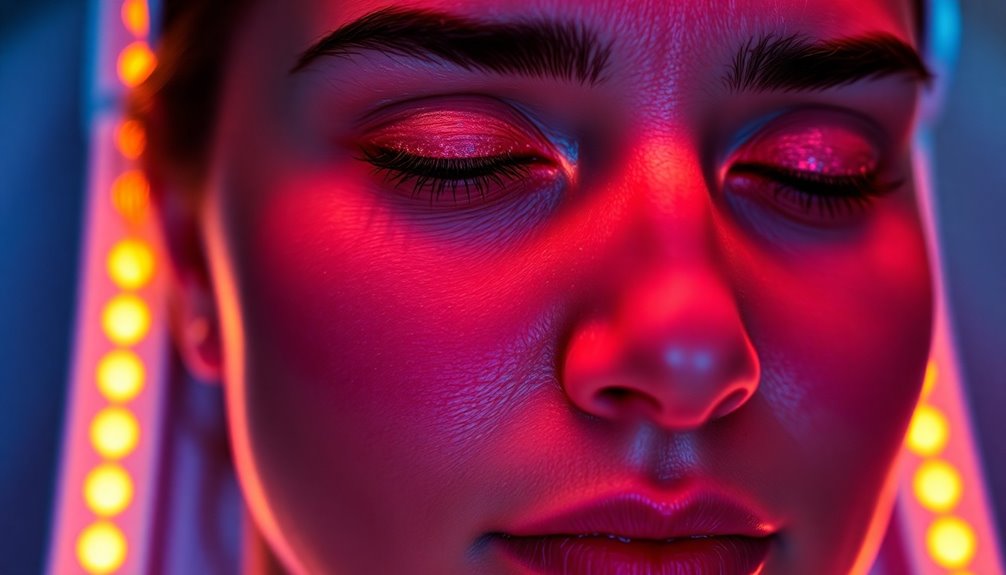
When using an LED light therapy mask, you might notice skin irritation and redness, especially if you have sensitive skin. Mild redness is a common response, but if you have existing skin conditions, you could experience more pronounced irritation. Not following usage guidelines can lead to blisters or increased irritation, so it's crucial to stick to the recommendations. If you're having prolonged or frequent sessions, that might heighten your risk as well. Pay attention to symptoms like itching, dryness, or even mild inflammation, as these indicate your skin's reacting negatively. To prevent this, start with shorter sessions and always keep your skin moisturized. It's also important to remember that consistency in use enhances effectiveness, so be mindful of how often you use your mask. If irritation persists, it's best to consult a dermatologist for tailored advice.
Reduced Effectiveness
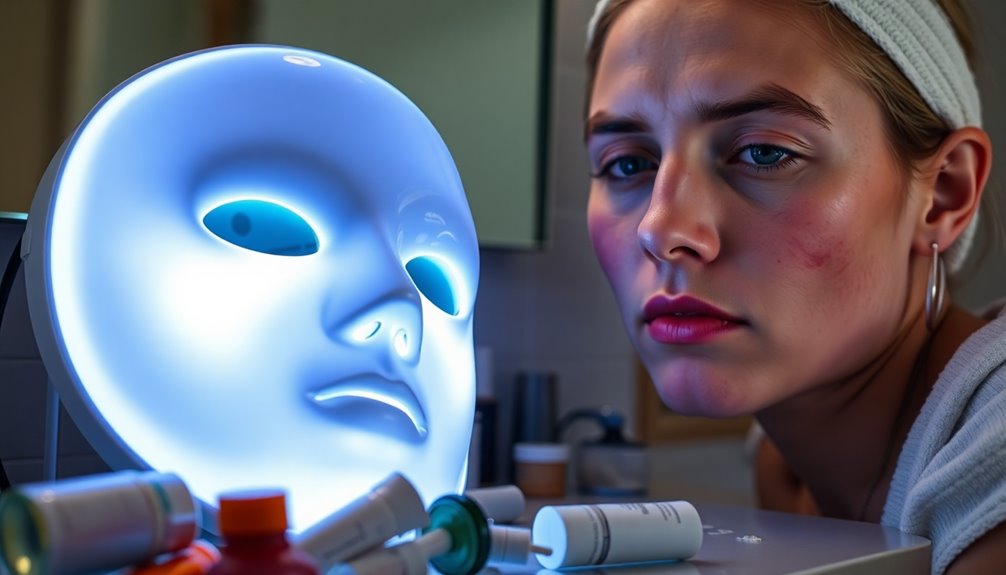
While LED light therapy masks can deliver impressive results, overusing them can lead to reduced effectiveness. Your skin may become accustomed to the treatment, resulting in diminishing returns and plateauing effects. Instead of seeing continued improvement, you might notice that your skin is less responsive over time. Overuse can also increase sensitivity, making your skin more prone to irritation and discomfort. Disrupting your skin's natural barrier can lead to infections and other issues. Remember, consistency is key; cramming multiple sessions into one day won't accelerate your results. It's essential to understand that excessive exposure can result in increased skin sensitivity, which underscores the importance of moderation in your treatment routine. Always adhere to the manufacturer's guidelines for treatment duration and frequency to maintain the benefits. Less can be more when it comes to achieving optimal results with your LED mask.
Eye Damage
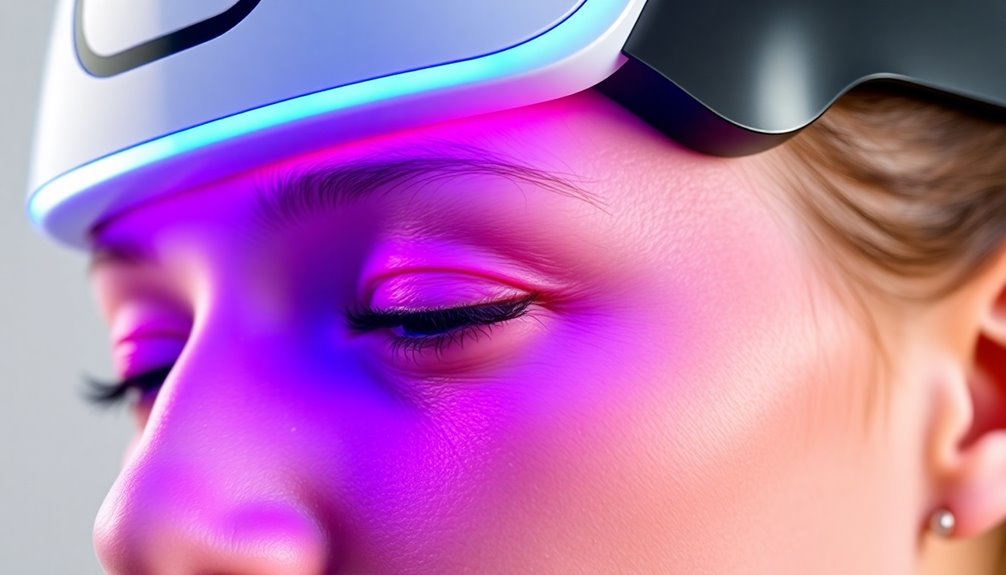
Although LED light therapy masks can enhance your skincare routine, improper use may lead to serious eye damage. High-intensity light exposure poses risks, such as retinal damage and peripheral vision loss.
Even with eye cutouts, spillover light can harm your eyes. Prolonged exposure to bright light increases these risks. Always avoid looking directly at the light, and be sure to wear protective goggles. Moreover, it's important to note that devices must be FDA-cleared to ensure safety standards are met.
Not following the manufacturer's instructions regarding treatment duration and eye protection can lead to serious issues. If you have pre-existing retinal conditions or take light-sensitive medications, consult your eye doctor before using these masks.
Photosensitivity
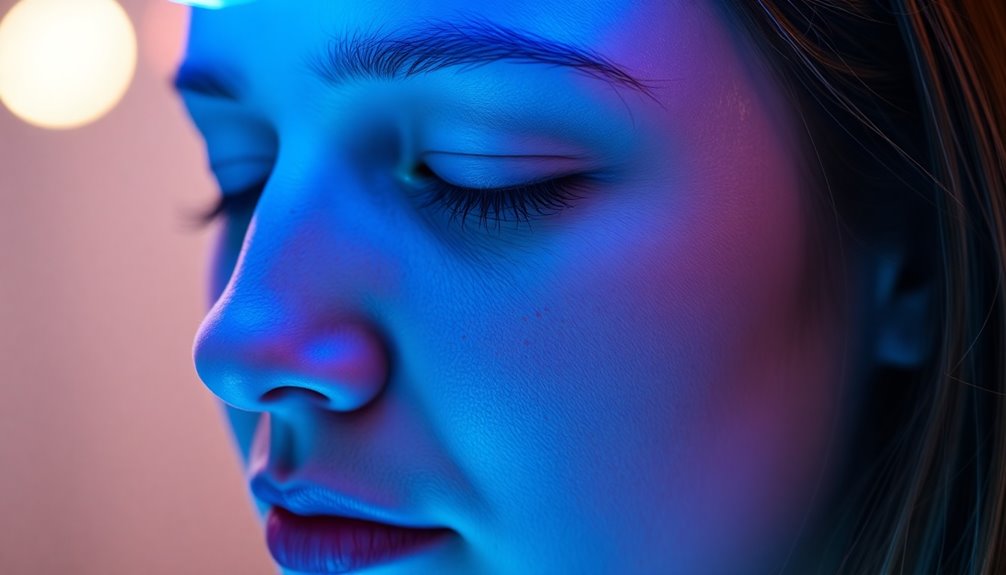
Photosensitivity can be a significant concern for those using LED light therapy masks, especially if you've got certain medications or skin conditions.
When your skin becomes abnormally sensitive to light, it can lead to redness, irritation, and discomfort, particularly with excessive use. Medications like antibiotics or diuretics, along with herbal remedies such as St John's Wort, can increase your sensitivity. If you suffer from photosensitive disorders like lupus or albinism, you should avoid LED therapy altogether. Always perform a baseline test on your forearm before regular use to check for sensitivity. Follow the manufacturer's guidelines for treatment times to ensure you're using the mask safely and effectively without risking your skin's health. It is also crucial to note that the device should be used 3-5 days per week for optimal results.
Device Quality
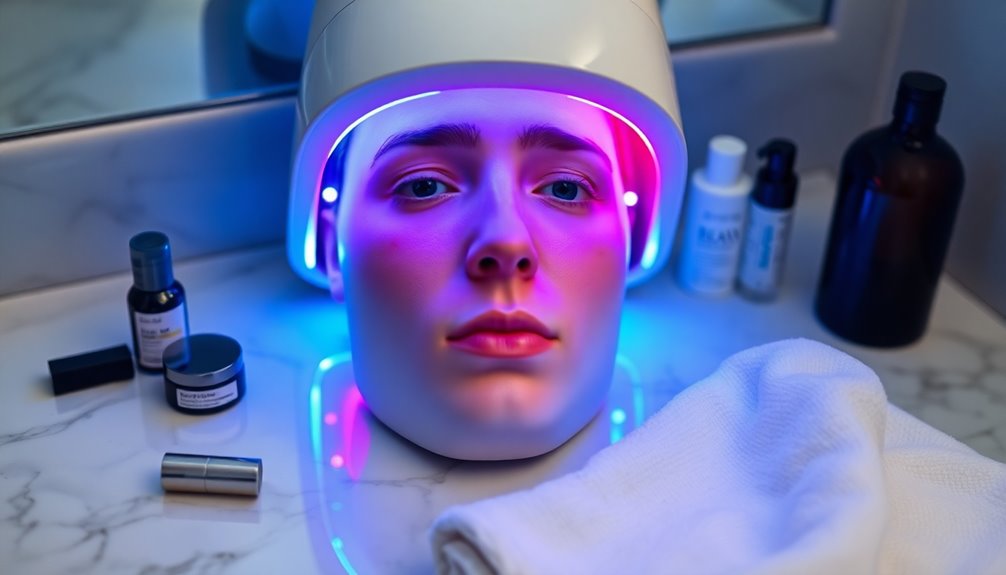
Using an LED light therapy mask can be highly beneficial, but the quality of the device plays a significant role in achieving effective results. The efficacy of the treatment depends largely on the wavelengths emitted by the mask, with specific colors targeting various skin concerns like acne, aging, and inflammation. Understanding how LED light therapy functions allows users to choose the right type of mask for their needs, maximizing the positive effects on their skin. Additionally, consistent use, combined with quality ingredients in skincare, can enhance the overall outcome, resulting in a healthy, radiant complexion.
High-quality masks, like LumaLux, feature a dense array of LEDs, ensuring thorough coverage and faster treatments. The precise wavelength of these LEDs is crucial for effective skin care. Masks with higher irradiance levels provide more power density, allowing for quicker and more effective treatment sessions.
Look for devices with at least 800 LEDs, as they deliver professional-grade energy output, significantly enhancing treatment efficacy. Additionally, ensure your mask has safety certifications and aligns its power output with energy peak power for optimal results.
Frequently Asked Questions
How Often Should I Use My LED Light Therapy Mask?
You should use your LED light therapy mask about 3-5 times a week for the best results.
Each session typically lasts 10-20 minutes. It's important to stay consistent, as this helps you see cumulative benefits over time.
After achieving your desired results, you can switch to maintenance sessions.
Always follow the manufacturer's guidelines and adjust based on your skin's needs and how it responds to the treatment.
Can I Use Other Skincare Products After Treatment?
After treating your skin with an LED mask, think of it as a special moment of care.
You can definitely use other skincare products afterward! Just make sure your skin's clean beforehand.
Hydrating toners or serums can work wonders, followed by a nourishing moisturizer. This way, you'll keep your skin feeling fresh and healthy.
What Should I Do if I Experience Irritation?
If you experience irritation after using your LED light therapy mask, first assess your skin.
Look for redness, dryness, or increased sensitivity. You might want to reduce the frequency of use or shorten your sessions.
Always layer on a hydrating serum post-treatment to combat dryness.
If irritation persists, consider switching to a lower intensity setting or consulting a dermatologist for personalized advice.
Keeping a balanced skincare routine is essential for healthy skin.
Are There Any Age Restrictions for Using These Masks?
Yes, there are age restrictions for using LED light therapy masks.
They're not recommended for children under 14, as safety hasn't been tested.
If you're a teen or pre-teen, avoid using red light therapy for anti-aging until your early 20s.
Blue light therapy for acne should only be used under medical supervision if you're under 18.
Always consult your healthcare provider before starting any treatment to ensure safety and effectiveness.
Can I Use the Mask on Sensitive or Acne-Prone Skin?
Yes, you can use the LED mask on sensitive or acne-prone skin.
It's designed with gentle materials that won't irritate, making it safe for sensitive skin. The blue light targets acne-causing bacteria, while red light helps reduce inflammation.
To maximize benefits, consider combining both light therapies.
Just remember to apply a hydrating serum post-treatment and maintain a consistent routine of 3 to 5 times a week for the best results.
Conclusion
In the glowing world of LED light therapy, your mask should feel like a gentle sunbeam, not a scorching sun. If you're noticing skin irritation, reduced effectiveness, or even signs of eye damage, it's time to pause and reflect. Just as a flower needs the right amount of sunlight to bloom, your skin thrives on balance. Embrace moderation, and let your skin flourish in harmony with the light, rather than getting lost in its dazzling intensity.
